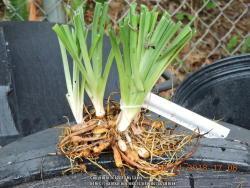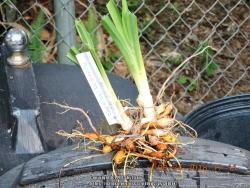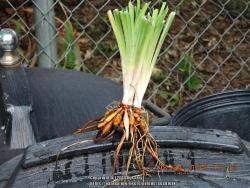Lets talk about daylily roots. I have some examples and need some advice.
Some daylilies have a lot of very fine roots, what I call "feeder roots". They also have some thicker roots that I call "stabilizing roots" and then some of them have those "thick tuberous roots".
I had promised some fans of some of the older varieties to a member and as I dug and separated them I realized how different the plants roots were and how hard some were to separate while others were much easier.
The one takeaway I got from this session was that dividing plants every couple of years makes for easier dividing. Some of the older clumps were a real pain, I tried my best to just get nice respectable single fans or double fans without cutting the roots(something I hate to do) but there was just no avoiding it. I sawed my way through trying to find a nice path with the least resistance, but with a solid mass of roots intertwined into a nightmarish mess it was not to be. So I just sawed through the mass and hoped for the best.
I did have two plants 'Irish Envy' and 'Laura Harwood' that had tons of fine roots, others had very few of these roots. One of the hardest clumps to divide that had almost none of the fine feeder roots comparatively was 'Lady Neva' but even though the plant had several crowns, it was if they had all meshed together as one plant, and it had to be hacked up in pieces.
I removed hands full of the small "feeder roots' from a couple of the plants and my question is what percentage of those feeder roots can be removed without doing great harm to the plant. I could barely fit the plants in a large priority shipping box but without extreme trimming of the foliage it would not have been financially possible to ship the plants. I think I have read that they can mostly be removed and that they will die back any how when planted and then regrow. The larger roots were very long also so I cut them back about a third, just to be able to fit the plants in the box.
Any advice on trimming back the roots, would be appreciated.
P.S.
I did knock off all the dirt I could, I did take the hose and wash them and remove as much dirt as I could, I did soak them and then wash them again. Still had to saw through them.
These are some of the remains that were not shipped just to show the different roots. I wish I had taken before and after photos, but as usual, I thought of it to late.
'Lady Neva'

'Laura Harwood' very hard to separate, I must have removed several pounds of fine roots.

'Mister Lucky': The clump was transplanted in the past two years so it was pretty easy

'Carnival In Mexico' Look how these roots appear to be stacked

'Irish Envy" very hard to separate, the clump had been divided just by digging a few fans from the edge over the past two years, but the clump had not been dug till today.





